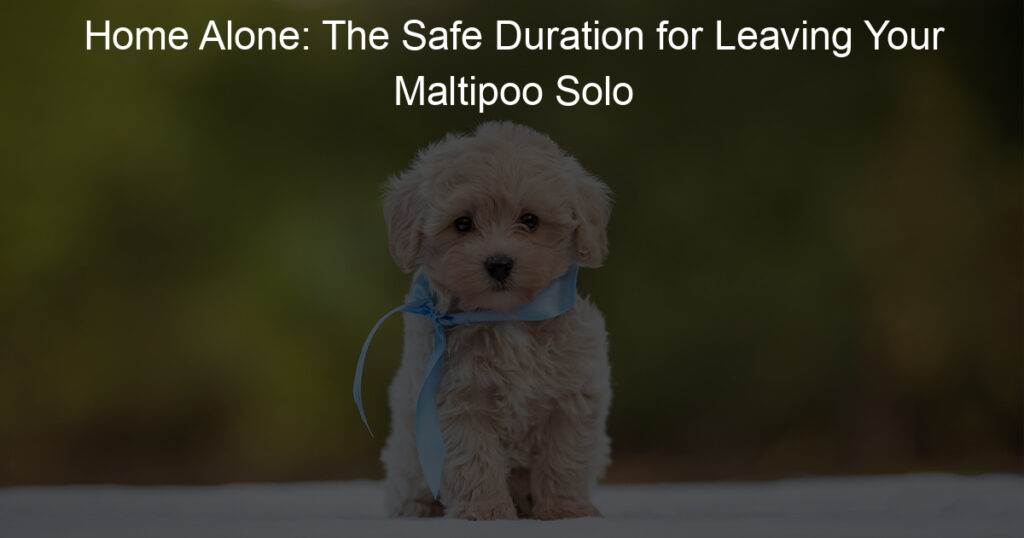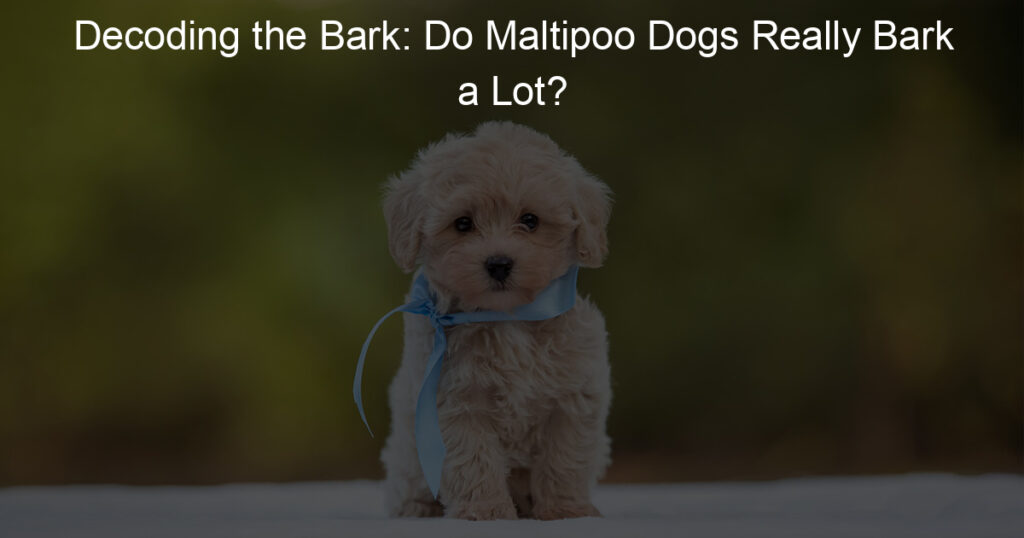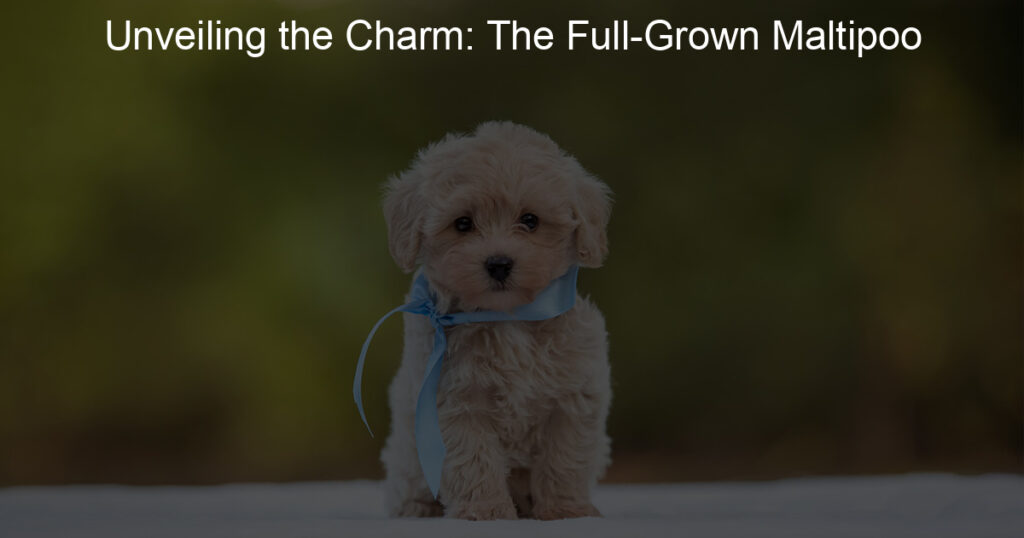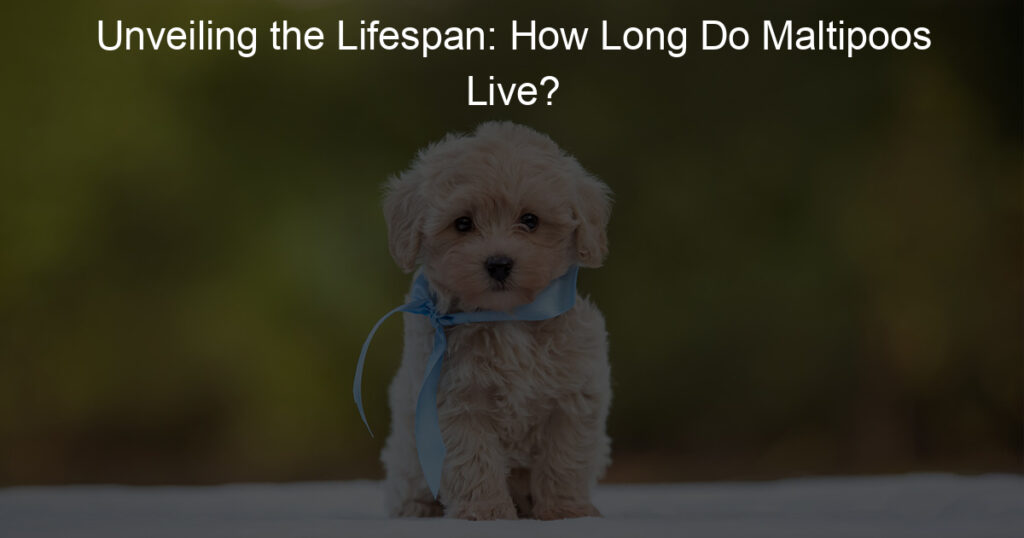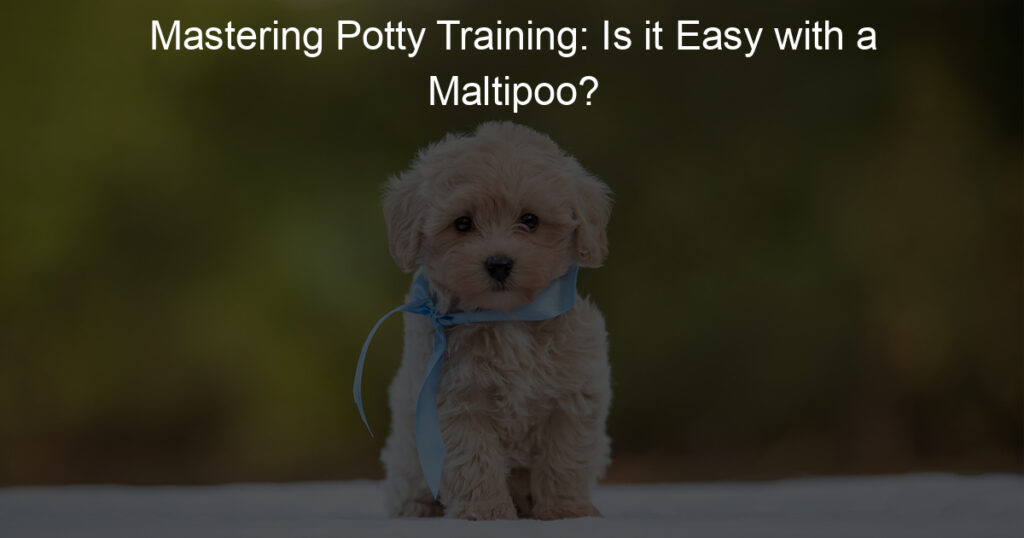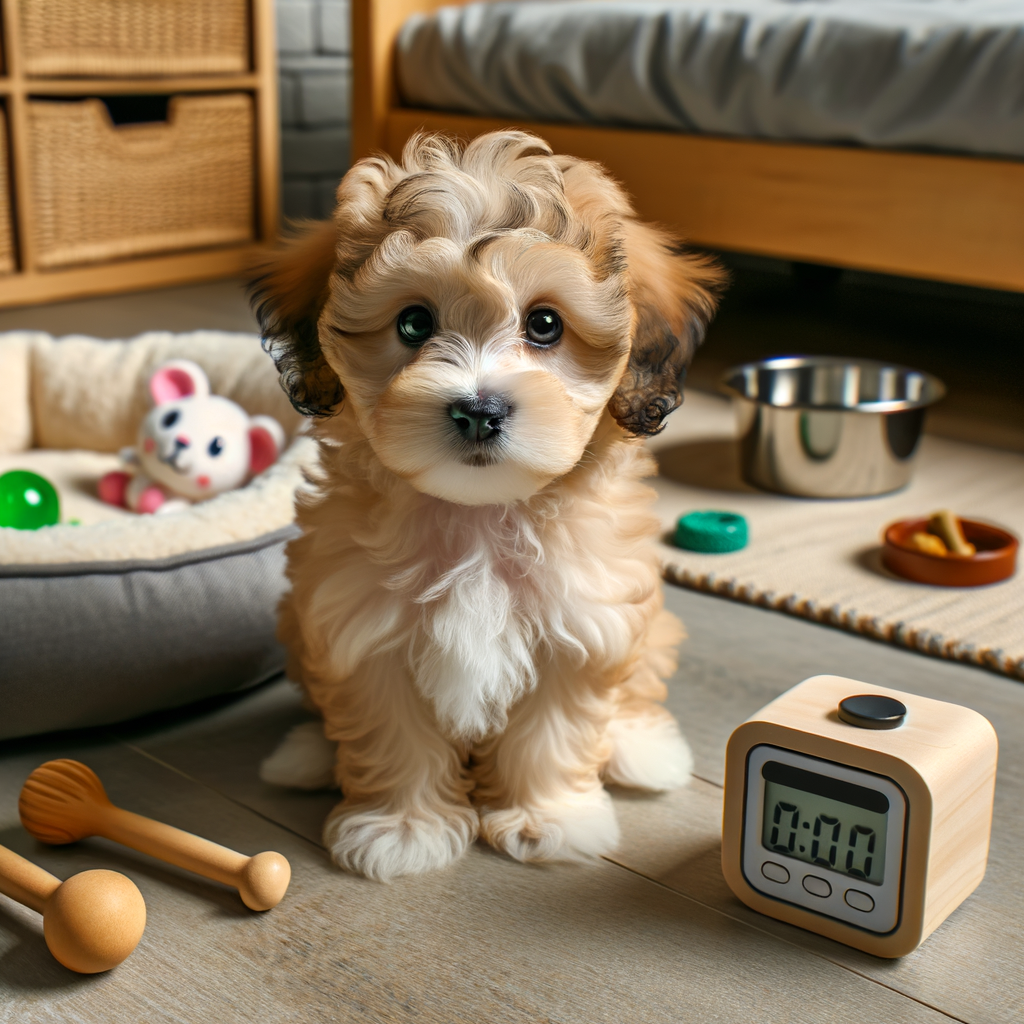
Introduction to Maltipoo Alone Time
When it comes to taking care of a Maltipoo, one of the most important aspects to consider is their alone time. This is a crucial part of their daily routine and overall well-being. Let’s delve into understanding this concept and its importance.
- Understanding the concept of Maltipoo alone time
- Importance of alone time for a Maltipoo
Alone time for a Maltipoo refers to the period when your furry friend is left by themselves. This could be when you’re at work, running errands, or simply when you’re in another room. Maltipoos, like all dogs, are social animals. However, they also need time to rest, relax, and engage in independent activities. This helps them develop a sense of self-reliance and confidence.
Alone time is not just about giving your Maltipoo a break from social interactions. It’s also about teaching them to be comfortable when they are by themselves. This is crucial for their mental health and prevents issues such as separation anxiety. It also gives them a chance to explore their environment, play with their toys, and simply enjoy their own company. A well-adjusted Maltipoo who is comfortable being alone is a happy and healthy Maltipoo.
In the following sections, we will explore more about leaving Maltipoos alone, signs of separation anxiety, and how to train your Maltipoo to be comfortable when left alone. We will also discuss how long is too long to leave a Maltipoo alone, and provide essential tips for their care during alone time. Stay tuned to learn more about this important aspect of Maltipoo care and independence.
Leaving Maltipoos Alone: What You Need to Know
Leaving your Maltipoo alone can be a challenging task. These adorable, intelligent, and affectionate pets are known for their love of company, making it difficult for them to be alone for extended periods. In this section, we will discuss the factors influencing the duration of Maltipoo alone time and the risks associated with leaving Maltipoos alone for extended periods.
- Factors influencing the duration of Maltipoo alone time
- Age: Younger Maltipoos require more attention and care than older ones. Puppies should not be left alone for more than 2-3 hours, while adult Maltipoos can manage 4-6 hours.
- Health: If your Maltipoo has a health condition or is on medication, they may need more frequent care and should not be left alone for long periods.
- Training: Maltipoos that have been trained to be alone can handle longer periods of solitude than those that haven’t.
- Risks associated with leaving Maltipoos alone for extended periods
- Separation Anxiety: Maltipoos are prone to separation anxiety, which can lead to destructive behavior and health issues.
- Loneliness: Maltipoos are social animals and can become depressed if left alone for too long.
- Accidents: Without supervision, Maltipoos can get into accidents, like ingesting something harmful.
Several factors can influence how long a Maltipoo can be left alone. These include:
Leaving your Maltipoo alone for too long can lead to several risks:
In conclusion, while it is possible to leave your Maltipoo alone for a few hours, it’s important to consider their age, health, and training. Always ensure they have plenty of toys and activities to keep them occupied, and consider a pet sitter or doggy daycare if you’ll be away for an extended period.
Maltipoo Separation Anxiety: Signs and Solutions
Separation anxiety is a common issue among Maltipoos. These adorable, fluffy companions are known for their affectionate nature and strong bond with their owners. Consequently, they can experience distress when left alone. In this section, we will discuss the signs of separation anxiety in Maltipoos and provide effective strategies to manage this condition.
- Identifying signs of separation anxiety in Maltipoos
Recognizing the signs of separation anxiety in your Maltipoo is the first step towards addressing the issue. These signs can vary from one dog to another, but there are common indicators to watch out for. These include:
- Excessive barking or howling when left alone
- Destructive behavior such as chewing on furniture or shoes
- Pacing in an obsessive pattern
- Attempts to escape from the area where they are confined
- Accidents in the house despite being house trained
If your Maltipoo displays any of these behaviors, it could be a sign of separation anxiety. It’s important to address these symptoms promptly to prevent them from escalating.
- Effective strategies to manage Maltipoo separation anxiety
Managing separation anxiety in Maltipoos requires patience, consistency, and a gentle approach. Here are some strategies that can help:
- Gradual desensitization: Start by leaving your Maltipoo alone for short periods and gradually increase the duration. This helps your pet get used to your absence.
- Provide plenty of exercise: Regular physical activity can help reduce anxiety. A tired Maltipoo is a happy Maltipoo!
- Establish a calm departure and arrival: Making a big fuss when you leave or return home can increase anxiety. Try to be calm and low-key during these times.
- Offer distraction: Leave toys or treat-filled puzzles to keep your Maltipoo occupied while you’re away.
Remember, every Maltipoo is unique and what works for one may not work for another. It may take some time to find the right approach for your furry friend. If your Maltipoo’s separation anxiety persists or worsens, it’s advisable to consult a professional dog behaviorist or your vet.
Maltipoo Home Alone Duration: How Long is Too Long?
Leaving your Maltipoo home alone can be a challenging decision. It’s important to understand the recommended duration and factors that can affect this time. Let’s explore these aspects.
- Recommended duration for leaving a Maltipoo home alone
The recommended duration for leaving a Maltipoo home alone is generally around 4 to 6 hours. This breed is known for their social nature and love for companionship, making them less suitable for long periods of solitude. However, every dog is unique, and some Maltipoos may be able to handle slightly longer periods alone, especially if they have been properly trained and are comfortable in their environment.
- Factors that can extend or shorten the safe home alone duration
Several factors can influence how long a Maltipoo can safely stay home alone. These include:
- Age: Younger puppies require more attention and care, so they should not be left alone for more than 2 hours. Older dogs, on the other hand, may be able to stay alone for up to 6 hours.
- Training: A well-trained Maltipoo that’s used to being alone can handle longer periods of solitude.
- Health: If your Maltipoo has health issues, they may need more frequent care and should not be left alone for long periods.
- Comfort: A comfortable, safe environment with toys and a cozy bed can help your Maltipoo feel more secure when alone.
Remember, every Maltipoo is unique and may have different needs. It’s always best to consult with a professional or your vet to determine the best approach for your furry friend.
Safely Leaving Maltipoos: A Comprehensive Guide
Leaving your Maltipoo alone at home can be a daunting task. However, with the right preparation and care, you can ensure their safety and comfort. Let’s delve into the steps you should take before leaving your Maltipoo alone.
Preparation Before Leaving
Before you leave your Maltipoo alone, it’s crucial to prepare adequately. This preparation involves creating a safe environment and ensuring they have enough food and water. Let’s look at these steps in detail.
- Ensuring a safe environment for the Maltipoo
- Providing enough food and water
Firstly, it’s essential to create a safe space for your Maltipoo. Remove any hazardous items, such as electrical cords, small objects they could choke on, or toxic plants. Make sure their play area is secure and free from potential dangers. It’s also a good idea to leave their favorite toys and a comfortable bed for them to relax in.
Secondly, make sure your Maltipoo has enough food and water. Depending on how long you’ll be away, you might need to invest in an automatic feeder and water dispenser. These devices can ensure your pet has access to fresh food and water throughout the day. Remember, a well-fed Maltipoo is a happy Maltipoo!
By following these steps, you can ensure that your Maltipoo is safe and comfortable while you’re away. Remember, preparation is key when it comes to leaving your pet alone. So, take the time to create a safe and welcoming environment for your Maltipoo, and make sure they have enough food and water to last until you return.
During Your Absence
When you’re away from home, it’s essential to ensure that your Maltipoo is safe, comfortable, and well-cared for. There are a couple of strategies that you can employ to monitor your pet and provide them with the necessary care.
- Monitoring your Maltipoo remotely
- Arranging for a pet sitter or neighbor check-in
Thanks to modern technology, you can keep an eye on your Maltipoo even when you’re not at home. There are various pet monitoring systems available that allow you to watch your pet through a live video feed. Some systems even allow you to interact with your pet, dispense treats, and send voice messages. This can be a great way to keep your Maltipoo company and ensure they’re safe while you’re away.
If you’re going to be gone for an extended period, it might be a good idea to arrange for a pet sitter or ask a trusted neighbor to check in on your Maltipoo. They can ensure that your pet has enough food and water, take them for walks, and provide them with some much-needed companionship. Remember, Maltipoos are social animals and can get lonely if left alone for too long.
In conclusion, while it’s okay to leave your Maltipoo alone for short periods, it’s important to have a plan in place to ensure they’re well cared for during your absence. Whether you choose to use a pet monitoring system or enlist the help of a pet sitter or neighbor, the key is to ensure your Maltipoo feels safe, loved, and well cared for.
Returning Home
After a period of absence, returning home to your Maltipoo is an important moment. Your actions during this time can have a significant impact on your pet’s wellbeing. Here are some key steps to follow:
- Checking for signs of distress or damage
Upon your return, it’s crucial to inspect your home for any signs of distress or damage. This could be an indication that your Maltipoo has been experiencing separation anxiety. Look for signs such as chewed furniture, scratches on doors, or soiled areas. If you notice any of these signs, it’s important to address the issue promptly. This could involve adjusting your Maltipoo’s alone time, providing more toys or activities, or seeking advice from a professional trainer or vet.
- Reassuring and comforting your Maltipoo
After checking for signs of distress, it’s time to reassure and comfort your Maltipoo. Your pet may have missed you greatly and needs to know that you’re back and everything is okay. Spend some quality time with your Maltipoo, petting them and speaking in a calm, soothing voice. However, be careful not to overdo it. Overly enthusiastic greetings can inadvertently reward anxious behavior. Instead, aim for a calm and comforting approach to help your Maltipoo feel safe and secure.
In conclusion, returning home to your Maltipoo involves careful observation and a gentle, reassuring approach. By following these steps, you can help ensure your pet’s wellbeing and reduce the likelihood of separation anxiety.
Maltipoo Alone Training: Building Independent Behavior
Training your Maltipoo to be comfortable alone is an essential part of their development. This process involves gradually increasing their alone time, creating a comforting routine, and using toys and puzzles to keep them engaged. Let’s delve into these strategies in more detail.
- Gradually increasing alone time
- Creating a comforting routine
- Using toys and puzzles to keep the Maltipoo engaged
It’s important to start slow when training your Maltipoo to be alone. Begin by leaving them alone for short periods, such as 15 minutes, and gradually increase this time as they become more comfortable. This method helps to build their confidence and reduces the risk of separation anxiety.
Consistency is key in helping your Maltipoo feel safe when alone. Establish a routine that includes feeding, walking, and playtime at the same times each day. This predictability can help reduce anxiety and make them feel more secure when you’re not around.
Keeping your Maltipoo mentally stimulated while you’re away can help alleviate boredom and anxiety. Toys and puzzles are excellent tools for this. Consider rotating the toys to keep things fresh and exciting for your pet. This way, they’ll have something to look forward to when they’re alone.
In conclusion, training your Maltipoo to be comfortable alone is a gradual process that requires patience and consistency. By gradually increasing their alone time, creating a comforting routine, and using toys and puzzles to keep them engaged, you can help build their independence and reduce the risk of separation anxiety.
Understanding Maltipoo Loneliness: Symptoms and Solutions
Loneliness in Maltipoos is a serious issue that can lead to health problems and behavioral changes. It’s essential to understand the signs of loneliness in these adorable pets and how to address it effectively. In this section, we will delve into the symptoms of Maltipoo loneliness and provide practical solutions.
-
Recognizing Signs of Loneliness in Maltipoos
Maltipoos are social creatures and thrive on companionship. When they feel lonely, they may exhibit certain behaviors. Some of the common signs of loneliness in Maltipoos include:
- Excessive Barking: This could be a cry for attention or a sign of distress.
- Chewing on Furniture: This behavior is often a result of boredom or anxiety.
- Loss of Appetite: A lonely Maltipoo may lose interest in food.
- Depression: Maltipoos may appear sad, uninterested in play, or sleep more than usual.
These signs can vary from one Maltipoo to another. If you notice any of these behaviors, it’s important to take action immediately.
-
Addressing Maltipoo Loneliness Through Companionship and Stimulation
There are several ways to help your Maltipoo overcome loneliness. Here are some effective strategies:
- Companionship: Spend quality time with your Maltipoo. Play games, go for walks, or simply cuddle on the couch.
- Stimulation: Provide toys and puzzles to keep your Maltipoo mentally stimulated when you’re not around.
- Socialization: Arrange playdates with other dogs. This can help your Maltipoo develop social skills and reduce feelings of loneliness.
- Training: Teach your Maltipoo to be comfortable when alone. Start with short periods and gradually increase the duration.
Remember, every Maltipoo is unique. What works for one might not work for another. It’s important to try different strategies and see what works best for your pet.
In conclusion, understanding and addressing Maltipoo loneliness is crucial for their wellbeing. By recognizing the signs and providing companionship and stimulation, you can help your Maltipoo lead a happy and healthy life.
Maltipoo Alone Care: Essential Tips
When it comes to leaving your Maltipoo alone, there are a few key areas you need to focus on. These include ensuring their physical safety, providing mental stimulation, and addressing potential health concerns. Let’s delve into these points one by one.
- Ensuring Physical Safety
- Providing Mental Stimulation
- Addressing Potential Health Concerns
Your Maltipoo’s physical safety should be your top priority when they’re home alone. Make sure all doors and windows are securely closed and locked. Remove any small objects that your pet could swallow and choke on. Also, keep all toxic substances, like cleaning supplies or certain plants, out of your Maltipoo’s reach. It’s a good idea to provide a safe, comfortable space for your Maltipoo, like a crate or a designated room.
Maltipoos are intelligent and active dogs that require mental stimulation to stay happy and healthy. When left alone, they can become bored and may start to exhibit destructive behaviors. To prevent this, leave out toys that challenge them mentally, like puzzle toys or treat-dispensing toys. You can also hide treats around the house for your Maltipoo to find, which can keep them occupied for hours.
Before leaving your Maltipoo alone, it’s crucial to address any potential health concerns. Make sure your pet has access to fresh water at all times. If your Maltipoo has any medical conditions, ensure they have taken their medication before you leave. Also, it’s a good idea to have a trusted neighbor or pet sitter check on your Maltipoo if you’ll be gone for an extended period.
In conclusion, taking care of a Maltipoo when they’re alone involves more than just leaving them with food and water. It requires careful planning and consideration of their physical and mental needs. By following these tips, you can ensure your Maltipoo is safe, happy, and healthy even when they’re home alone.
Maltipoo Solitude Safety: A Case Study
Our understanding of Maltipoo solitude safety is enriched by practical experiences. In this section, we delve into a real-life case study that offers valuable insights into the best practices for leaving Maltipoos alone.
- Introduction to the case study
- Key findings and takeaways
- Gradual Training: Max responded well to gradual alone-time training. Starting with short periods and gradually increasing the time helped Max adjust to being alone.
- Comfortable Environment: Ensuring a safe and comfortable environment, including access to toys, water, and a cozy bed, reduced Max’s anxiety.
- Regular Exercise: Regular walks and playtime before the Johnsons left for work helped Max expend energy and remain calm during their absence.
- Consistent Schedule: Maintaining a consistent schedule of leaving and returning home helped Max understand and anticipate the routine.
Our case study revolves around a Maltipoo named Max. Max’s owners, the Johnson family, were concerned about leaving him alone at home due to their busy work schedules. They sought professional advice and implemented a series of strategies to ensure Max’s safety and comfort during their absence.
Through their journey with Max, the Johnson family discovered several key points about Maltipoo solitude safety:
These findings underscore the importance of a thoughtful approach to Maltipoo solitude safety. By understanding and addressing their pet’s needs, owners can ensure a positive experience for their Maltipoos when left alone.
In conclusion, this case study demonstrates that with the right strategies and understanding, Maltipoos can safely and comfortably spend time alone. It is essential for Maltipoo owners to invest time in training, creating a comfortable environment, and maintaining a consistent schedule to ensure their pet’s well-being.
Conclusion: Balancing Maltipoo Care and Independence
In this comprehensive guide, we’ve explored various aspects of leaving a Maltipoo alone. It’s clear that while these adorable pets are quite independent, they also require a certain level of care and attention from their owners. Now, let’s recap the key points and share some final thoughts on Maltipoo alone time.
- Recap of key points:
- Final thoughts on Maltipoo alone time:
Understanding the nature of Maltipoos and their need for companionship is crucial. Leaving them alone for too long can lead to separation anxiety, which can manifest in various ways such as destructive behavior, excessive barking, or even depression. It’s essential to gradually train your Maltipoo to stay alone and provide them with safe and engaging activities to keep them occupied. Regular exercise, mental stimulation, and a comfortable environment are also key to ensuring your Maltipoo’s wellbeing.
While Maltipoos can handle being alone for a few hours, they thrive when they have regular interaction and stimulation. As a Maltipoo owner, it’s your responsibility to find the right balance between giving your pet the independence they need and ensuring they receive the care and attention they deserve. Remember, a happy and healthy Maltipoo is one that feels loved, secure, and engaged.
As we conclude, it’s important to remember that every Maltipoo is unique. What works for one may not work for another. Therefore, it’s essential to understand your pet’s individual needs and adjust your care routine accordingly. With patience, love, and understanding, you can ensure your Maltipoo enjoys their alone time while also feeling safe and loved.

